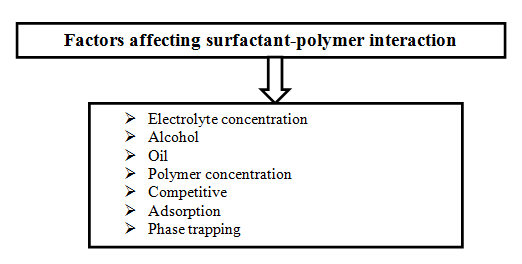ПРИМЕНЕНИЕ ПАВ–ПОЛИМЕРНОГО ЗАВОДНЕНИЯ В ПРОЦЕССАХ НЕФТЕОТДАЧИ
Дуненова А.А.
Докторант Phd, Казахский национальный технический университет имени К. И. Сатпаева
ПРИМЕНЕНИЕ ПАВ–ПОЛИМЕРНОГО ЗАВОДНЕНИЯ В ПРОЦЕССАХ НЕФТЕОТДАЧИ
Аннотация
В статье рассмотрено – эффективность и технология ПАВ – полимерного заводнения, взаимодействие и совместимость поверхностно-активного вещества и полимера.
Ключевые слова: пав–полимер, заводнение, нефтеотдача.
Dunenova A.A.
PhD student, Kazakh National Technical University after K. I. Satpaev
APPLICATION OF SURFACTANT–PILYMER FLOODING ON OIL RECOVERY PROCESSES
Abstract
The article considers efficiency and technology of surfactan - polymer flooding, surfactant – polymer interaction and compatibility.
Keywords: surfactan–polymer, flooding, oil recovery.
Surfactant-polymer flooding (also called micellar-polymer flood) was a potential enhanced oil recovery technology that was more powerful than the polymer flooding.
Oil and water phases are immiscible due to interfacial tension on the surface of two phases. This interfacial tension causes capillary forces. Surfactant-polymer flooding is used for decreasing capillary forces in watered reservoirs and displacing residual oil.
By adding special additives –surfactants it is possible to decrease the interfacial tension between two phases and they become miscible. After mixing with surfactants under certain conditions oil and water become one single homogeneous solution or emulsion. This produces so-called oil-water micelle-type aggregates of molecules of liquid crystals with liquid core, within which the oil and water molecules are able to move relatively to each other. Such solutions are called micellar solutions or micro emulsions.
The surfactant – polymer process. The surfactant-polymer injection is sometimes referred to as low tension polymer flooding. In surfactant/polymer flood, 0.1% to 2% of surfactant is added to the injected water in order to reduce the oil-water interfacial tension. Polymer is added for mobility control (increase solution viscosity) to help overcome the viscous instability in low interfacial tension displacement. A 20% to 40% pore volumes of this solution is first injected into the reservoir followed by the same volume of polymer flush.
Figure 1 shows an idealized version of micellar-polymer (MP) flooding sequence. The process is usually applied to tertiary floods and is always implemented in the drive mode (not cyclic or huff ’n puff). The complete process consists of the following:
Preflush. A volume of brine which purpose is to change (usually lower) the salinity of the resident brine so that mixing with the surfactant will not cause loss of interfacial activity. Preflushes range in size from 0% to 100% of the floodable pore volume (Vpf) of a reservoir. In some processes, a sacrificial agent is added to lessen the subsequent surfactant retention.

Figure 1. Idealized cross section of a typical micellar-polymer flood
Micellar-polymer slug. This volume, ranging from 5% to 20% Vpf in field applications, contains the main oil-recovering agent, the primary surfactant. Several other chemicals are usually needed to attain the design objectives.
Mobility buffer. This fluid is a dilute solution of a water-soluble polymer which purpose is to drive the MP slug and banked-up fluids to the production wells. The target oil for an MP flood––the residual oil––is different from that of a polymer flood––the movable oil.
Mobility buffer taper. This is a volume of brine that contains polymer, grading from that of the mobility buffer at the front end (the spike) to zero at the back. The gradual decrease in concentration mitigates the effect of the adverse mobility ratio between the mobility buffer and the chase water.
Chase water. The purpose of the chase water is simply to reduce the expense of continually injecting polymer. If the taper and mobility buffer have been designed properly, the MP slug will be produced before it is penetrated by this fluid.
Surfactant – polymer interaction and compatibility. When surfactant and polymer are injected in the same slug (SP flooding), their compatibility is an issue. Sometimes, polymer is injected before surfactant as a sacrificial agent for adsorption or for conformance improvement. Sometimes polymer is injected behind surfactant to avoid chase water fingering in the surfactant slug. Even though polymer is not injected with surfactant in the same slug, they will be mixed at their interface because of dispersion and diffusion. Polymer may also mix with surfactant owing to the inaccessible pore volume phenomenon when it is injected behind surfactant.
The main advantage of this method is the ability to recover up to 50-60% of residual oil from watered reservoirs.
Disadvantages of the method include the complexity of the technology and the great need for chemical reagents, including expensive ones.
References
- Ruzin, L. M., O. A. EOR methods (theory and practice ) // Uhta : UGTU, 2014. P. 127.
- Lake L. Enhanced Oil Recovery // Society of Petroleum Engineers, 2010.
- 414.
- James J. Sheng. Modern chemical enhanced oil recovery: theory and practice // Gulf Professional Publishing, 2011. P. 617.
